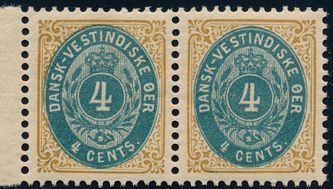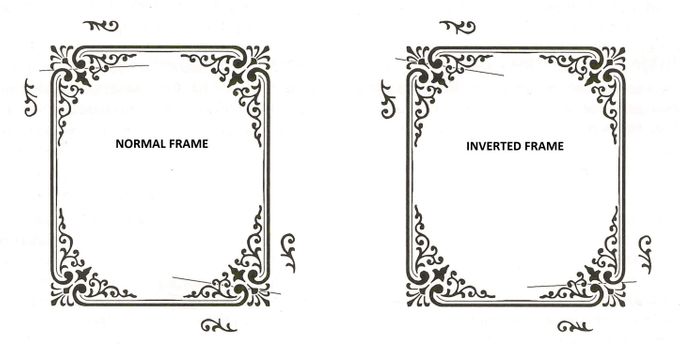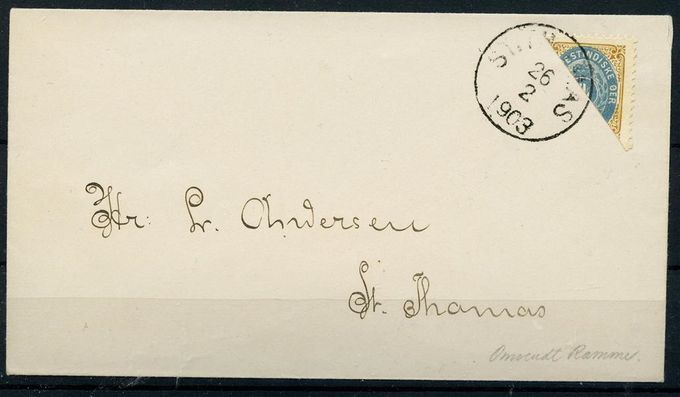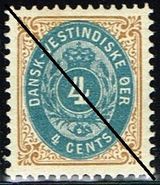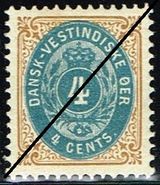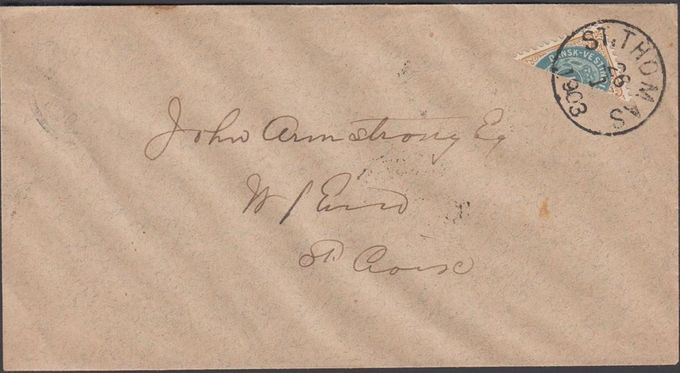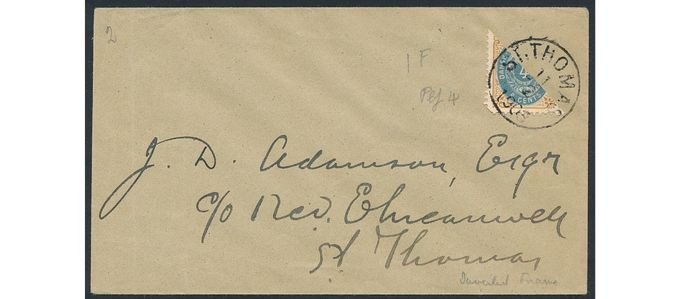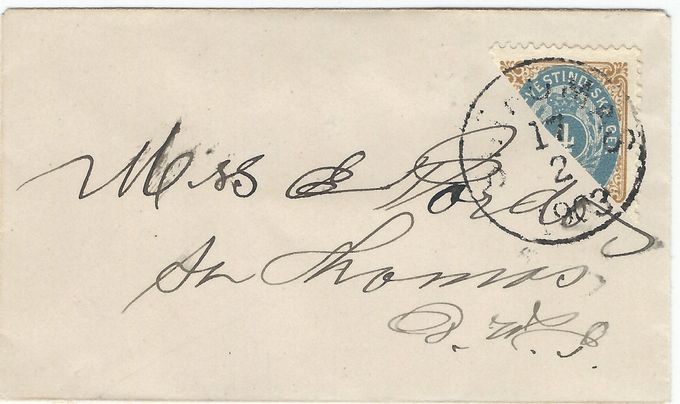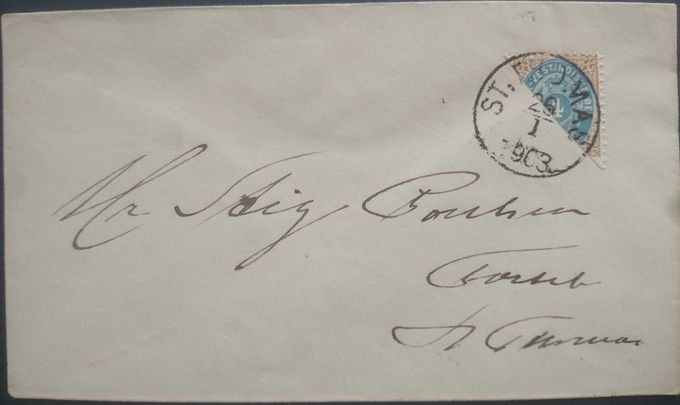PRINTINGS OF THE DWI 4 CENTS
1901. Printing 3 - pos. 51–52 INVERTED + NORMAL FRAME.
There are 4 printings of the 4 cents.
Printing 1:
(Sep 1873) - ultramarine/brown. Perforated 14 x 13 1/2. Inv. frames pos. 18 and 77.
Printing 2:
(May 1878) - light blue/yellow brown. Perforated 14 x 13 1/2. Printing 2 is not as common as printings 3 and 4. There are no inverted frames in Printing 2.
The stamps from printing two have a greater catalog value. Printing two stamps are likely stamps the collector had stashed away and put into use to perhaps generate another philatelic variety.
One person, a Mr. A. Duurloo - produced a number of small covers (95 x 54 mm- see photo below) with stamps from printing 2 that were all canceled St.Thomas May 6.
Stamps from Printing 2 are more often used on covers mailed from Christiansted and Frederiksted as compared to St. Thomas.
Printing 3:
(Mar 1901) - dull greenish slate blue/light yellow brown - one inverted frame in position 51. Perforated 12 3/4. Color variation appears which makes it difficult to identify Printing 3 from Printing 4.
Printing 4:
(Jun 1902) - clear light blue/yellow brown - 11 inverted frames in position 51 and 91-100. Perforated 12 3/4. Color variation appears which makes it difficult to identify Printing 4 from Printing 3.
Printing 4 is the most commonly used bisected 4 cents stamp.
It is not known how many stamps were biseced and used. Estimates have ranged from as few as 2.500 to as many as 53.000 - but there could easily have been more than 10.000 letters.
Mr. A. Duurloo mailed numerous tiny covers on May 6 using Printing 2. The cancel has the appearance of having been cleaned, and has the spelling with a “period” which is less used. Only 5% of all bisected 4 cents stamps were cancelled in May.
THE INVERTED FRAME
The inverted frame is defined by the upper left scroll design - but may also be identified in the bottom right corner.
When the frame in the upper left corner is inverted the stamp is defined as having an inverted frame - while the lower right frame on that same stamp is normal. And visa versa.
Relevant 4 cents inverted frames are Printing 3 pos. 51 and Printing 4 pos. 51 and 91-100.
Inverted frames are not present in Printing 2.
The inverted frame was not identified untill 1917 - so its use in philatelic mail was not deliberate.
First day cover from St.Thomas - inverted frame - printing 3 pos 51.
Double cancels are very unusual.
Inverted frame - easily identified in both upper left and lower right corners. Depending on the diagonal cut (see the bottom of this page) - you sometimes only have either the upper left or the lower right corner to identify the inverted frame.
Local St. Thomas cover cancelled February 26.
THERE ARE 4 POSSIBLE BISECT OUTCOMES WHEN CUTTING DIAGONALLY
Diagonal cut from the upper left corner to the lower right corner.
ONLY A DIAGONALLY CUT 4 CENTS STAMP WAS ALLOWED
The use of bisected 4 cents were only allowed by the staff of the Post Offices of DWI. Only diagonally cut 4 cents from the stock of the Post Offices and applied by the staff was allowed. This to prevent any false use of already cancelled 4 cents. If a stamp had been struck only hidding a small part of the stamp - it could have been removed - bisected and the part not showing any signs of being cancelled - reused.
In reality - many bisected stamps were applied by the sender - especially those being dropped in the letterboxes after opening hours. It is my impression - that the Post Offices on both St. Thomas and St. Croix gradually allowed people to apply bisected 4 cents stamps from their personal stock supplies.
Diagonal cut from the upper right corner to the lower left corner.
The initial intented use of the bisects was for local covers and postcards (as well as single and double postal cards) sent within 300 nautical miles. Further intended use was for printed matter not exceeding 50 grams sent beyond 1500 nautical miles.
OVAL FLAWS OF THE 4 CENTS
White spot between T and I. Printing 4 pos. 93 - inverted frame.
There are 4 common oval flaws of the 4 cents.
1: Oval scrath over TIN in "Vestindien". Appears in pos. 90 (Print. 2), pos. 23 (Print. 3) and pos. 75 (Print 4)
2: Horizontal line of large 4 is defect and appears pointing upward to the right. Pos. 40 (Print. 1), pos. 58 (Print 2), pos. 15 (Print. 3) and pos. 94 (Print 4). Note that the pos. 94 of Printing 4 is an inverted frame.
3: White spot between T and I. Appears in pos. 34 (Print. 1), pos. 8 (Print. 2), pos. 4 (Print. 3) and pos. 93 (Print. 4). Note that the pos. 93 of Printing 4 is an inverted frame.
4: White spot above E in "VEST". Appears in pos. 12 (Print. 3) and pos. 99 (Print. 4). Note that the pos. 99 of Printing 4 is an inverted frame.
Oval scrath over TIN in "Vestindien". Printing 3 - pos. 23.
Horizontal line of large 4 is defect and appears pointing upward to the right. Printing 4 - pos. 94. Inverted frame. (Online source).
White spot above E in "VEST". Printing 4 - pos. 99. Note the inverted frame.
White dot between T and I. Printing 3 pos. 4.
Del siden
